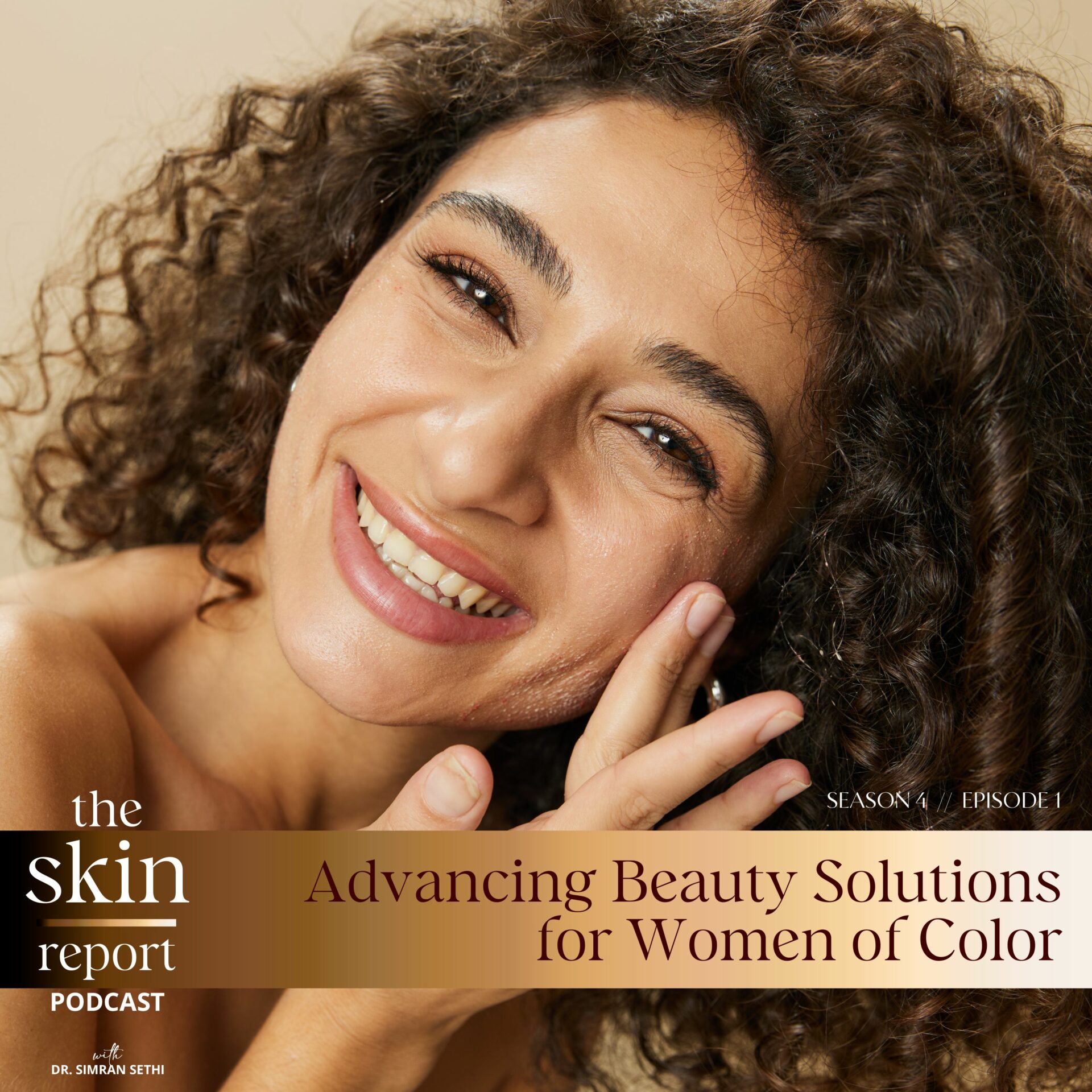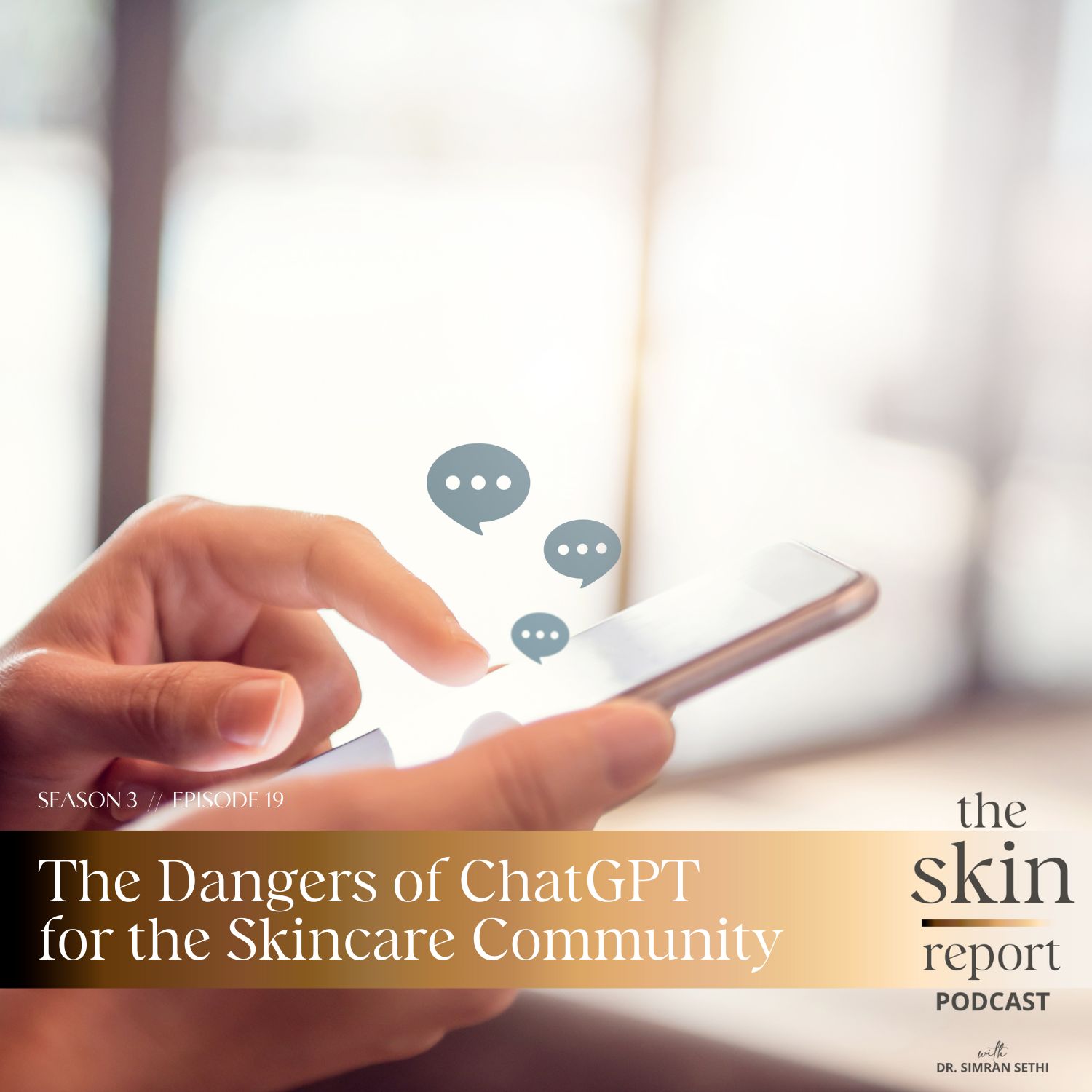Many different skin treatments claim to rejuvenate and benefit the skin. However, skin impacted by melasma can react differently to some skincare methods and ingredients, so not all tactics will benefit users with melasma. But if your melasma has become stubborn and resistant to changes in your skincare routine, what treatments can you use to target affected areas?
The Skin Report is a podcast created to educate listeners on methods to improve skin health for people of all ethnicities and ages. This week host Dr. Sethi concludes her October series on melasma by discussing laser skin treatments and how they affect skin impacted by this condition. She explains how various therapies affect skin with melasma, including chemical peels, microdermabrasion, facials, and lasers. Dr. Sethi shares her thoughts on the Picosure lasers for skin with melasma, and she explains how specific treatments can break up the pigment and stimulate collagen growth without aggravating skin cells. Additionally, this episode contains a surprise in act four, so tune in and enjoy!
Beauty Instagram: https://www.instagram.com/renewmd_beauty/
RenewMD Beauty Medical Spas, California: https://renewmdwellness.com/
This transcript was exported on October 17, 2022 -view latest version here.
Skincare can sometimes feel overwhelming, whether it’s finding the right products, ingredients, or treatments. There’s a lot out there, but not always for women of color. That’s why I set out to educate myself and others so that we can all feel beautiful in our skin. Hello and welcome to The Skin Report. I’m Dr. Simran Sethi, an internal medicine doctor, mom of three and CEO and founder of RenewMD medical spas and Skin by Dr. Sethi. If you’ve been following our show, you may know that we did a four-part series in September on skin of color and the skincare industry. I highly suggest going back and listening to that series as we share some valuable insights on racist practices in the beauty industry, common concerns for melanated skin and how to overcome them.
For the entire month of October, we’ll be launching a new series on one of those common yet misunderstood and under research skin conditions, melasma. This is our fourth and final episode, and as the series has built upon itself, I would highly recommend starting at our first show in October. So far, we’ve covered the science behind melasma, who is most susceptible and the lifestyle and skincare changes we can make to help prevent or reduce the effects of melasma. In this show, we’ll be discussing laser treatments. Are they harmful or helpful to those with melasma? Additionally, I will have a surprise at the end of this episode, so be sure to stick around to find out.
If your melasma has become stubborn and won’t respond to the changes in your skin care routine that we discussed, there are certain treatments you can do to target affected areas. You may have attempted to try chemical peels and for reasons we discussed in our previous episode, this can be tricky. You may also feel drawn to microdermabrasions, which is a minimally invasive treatment that is often used to treat skin tone and texture. It essentially polishes off the outer outermost dead skin cell layer of keratinocytes, which helps other skin care penetrate deeper for the rest of the month.
As it typically improves the skin’s look and feel. I can understand why those with melasma may be tempted to try microdermabrasions. Many facials claim to brighten skin, however, they’re going to be very limited in reducing pigment caused by melasma. Remember, while all pigment is produced in the epidermis, which is more superficial, in conditions like melasma, most of this pigment deposits in the deeper dermis as the basement membrane between the two layers is leaky. A microdermabrasion polishes off the keratinocytes or a dead cells layer at the very top of the epidermis, and then any products applied can penetrate only to the epidermis and not the deeper dermis. This is why a facial can never make a noticeable difference in melasma pigment reduction. Additionally, facials for relaxation look different than the ones that you want for results. We’ll be discussing this in a later episode. Because of these reasons I don’t consider facials or microdermabrasions a part of melasma treatments. So what can you do at a medical spa to reduce melasma’s pigmentation and other effects? Perhaps lasers, but we’ll see after the break.
Lasers are a broad category of devices that deliver energy. Their wavelength and the speed at which they deliver energy determine their effect and target. Most lasers use heat or light that penetrates the epidermis and dermis to stimulate collagen production, which gives the skin a glowing more youthful appearance. However, you may recall from the first episode in our October series that heat and light worsen melasma in patients. So how can we break up pigment and stimulate collagen growth without aggravating ourselves, thus producing more pigment as a result? How can any lasers be safe for those with melasma? I want to introduce you to the emergence of the PicoSure laser. PicoSure laser is a novel laser that delivers energy very, very fast so that the energy doesn’t have time to convert to heat or light as it touches the skin and reaches the epidermis or dermis.
In essence, the PicoSure laser can reach the dermis quickly to shatter pigment and collagen as opposed to heating it, which stimulates a reaction that triggers the skin to make new collagen very rapidly. I’ve used PicoSure laser safely in my offices for years on people with melasma and continue to create new, more customized treatment protocols with it. My medical practice is made of mostly women of color who are in the skin type three to five rate, and as we already discussed, melasma is a very common skin issue amongst this skin type. As a result, I see very advanced cases of melasma. These cases are often advanced due to several reasons, but primarily many of these patients have been turned away from other medical practices after being told that there aren’t any treatment options for them. Orthey’ve been treated with inappropriate lasers and peels that have worsened their symptoms.
Melasma treatments should never include treating with heat or light-based technologies. That means lasers, like intense pulse light, lasers, fractionated or CO2 lasers, clear and brilliant, halo are not suitable lasers for melasma treatment, as they generate heat and, or light that will further stimulate overly active melanocytes. Hence, one of the two reasons why I encounter very advanced cases is because of unsuitable treatment plans that others have put patients on. Innovation is a byproduct of necessity. As a physician I was, and still am, constantly challenged to find solutions for this skin condition that is emotionally taxing for my patients. My very advanced cases have led me to develop more aggressive combinations and variations in the energy use to rejuvenate the skin and break pigment with PicoSure lasers, tattoo removal lens. Sometimes if a patient is experiencing melasma flareups very frequently, I will also infuse the skin with plasma-rich platelets, which we’ll discuss in a later episode. The reason for this is not to break pigment, but actually quieten down melanocyte activity.
Most cases of melasma present when the pigment has leaked and deposited into the dermis, the deeper layer of the skin. This is an abnormal place for melanin deposition and usually the basement membrane. The layer between the epidermis and dermis can protect the movements of melanin and other substances between the two layers. However, with melasma, the basement membrane is leaky, which means that the excess pigment produced in the epidermis inevitably falls into the dermis. Once in the dermis, pigment is almost untouchable with most skin care and technologies. The PicoSure laser isthe only treatment that reaches the dermis and can use vibrational force to shatter pigment.
These protocols are complex and difficult to explain fully on a podcast, but the bottom line is this, there are options for melasma, but these have to be customized based on the depth of the pigment and how longstanding the skin condition has been and the patient’s skin type. Many women of color suffer from melasma, which is made worse by the lack of research and knowledge about the condition. I can’t say that we have a cure for melasma yet, but we do have better solutions today than we did just five years ago that prevents it from worsening and reverses most of the pigmentation. I’ve shared a lot of this knowledge with other aesthetic doctors so that they can also start incorporating these protocols into their practice, and now I want to share it with you through this October series, which brings me to my surprise. At the end of every episode, you may know that I encourage listeners to submit questions that they have about their skincare and you all delivered. We’ve received some great questions, the first of which I will answer when we get back.
I’m so excited and happy to see the questions coming in. This podcast is meant to start a dialogue and I can’t do that without you all. While the first question I’ll be addressing does not pertain to melasma specifically, it does touch on many of the related topics we covered in the October series. I received this question from Patricia G., who is 61. She asked, “I have overactive sebaceous glands and have always struggled with congested pores and ugly black heads. When I was younger, the chemical peels and microdermabrasions and Retin-A work for me. Now that I’m older, I have sensitive skin and just cannot find a balance thatkeeps the pores clean, but doesn’t make me red, irritated and peeling all the time. Please help. My ultimate goal is to not need to always wear foundation to hide my clogged skin.
“Patricia, I’m glad you asked this question because our skin changes so much through the years and even seasons and what may have worked when we were younger does not necessarily do as we age. As we age, our skin’s ability to repair damage and make new skin reduces and in women, there is this steeper decline in this process around menopause. As a result, mature skin has less collagen and elastin, which reduces the skin’s integrity and less lipid protection, as skin lipids are promoted by estrogen, which reduces with menopause. With less lipids in our skin, the skin barrier becomes compromised and this causes skin to feel more sensitive, dry and experienced more micro-tear with treatments like microdermabrasion facials, chemical peels, and even face brushes. More mature skin also cannot handle plain retinol application, as it will dry skin out even further. The way to bring your skin back to a balanced state with increased skin turnover, appropriate levels of lipid or natural oils and keep it strong is by incorporating the following steps.
First, stop all your products and go on a two-week skin cleanse, which only involves cleansing with a gentle hydrating cleanser, applying a lipid-rich moisturizer and a hyaluronic acid serum over the moisturizer. Top that off with sunblock. In my skincare line, this can be achieved easily with my line’s hydration kit, which includes all these steps. After two weeks, your skin should start feeling supple and less irritated. If you have lot of sensitivity, you may need to wait an additional week or two, but by the end of a month, your skin barrier would’ve had the chance to repair completely, making it possible to move to the next step in the process.
Two to four weeks after starting your skin regimen cleanse, your skin will now be strong enough to incorporate a retinol. You need the retinol to further strengthen your skin, as it promotes collagen production. You also want to reduce the size of your pores and congestion, which retinol will do as it increases skin cell turnover. The key here is to use a retinol along with a rich phospholipid product. My retinal lipid complex is designed to include a medium strength 5% retinol along with a phospholipid formula, but you can achieve this with combining true products as well. It is also important to start retinol slowly and steadily. Start using it twice a week, always only at night, and then a month later increase the usage to three times a week for a month and then just every other night. In more mature skin, using retinol every other night tends to be sufficient and reduces the chances of making the skin overly sensitive.
After a few months, your skin should be strong enough to handle microdermabrasion facials, which will further help your pores and skin congestion. Just remember to ask your facialist to incorporate a hydrating infusion with the microdermabrasion to restore extra moisture into the skin during the session. Patricia, I hope this was helpful, and if you’d like to learn more about how the skin and skincare changes with every age, you can always listen to episode three of The Skin Report for more details. Thank you so much for all your thoughtful questions and listening to our podcast.
If you’d like to learn more about science-backed skincare or medical aesthetic treatments, please subscribe to and turn on notifications for The Skin Report, so you always know when a new episode is up. We have a newsletter that you can sign up for on theskinreportbydrsethi.com so that you can stay up to date on all our new episodes, blogs, products, and more. Additionally, if you have a skincare question or want to make an episode topic recommendation, please message me at theskinreportbydrsethi.com, which is linked in my show notes, and I’ll be sure to answer your question in an episode soon. We’ve received some great questions so far, so keep them coming. Thanks for listening in. Until next time, love the skin you are in and celebrate your beauty.
Transcript by Rev.com











